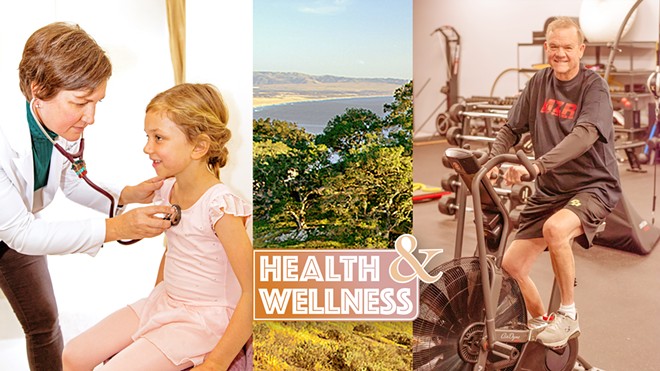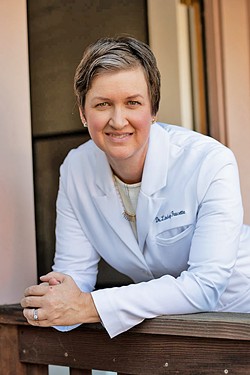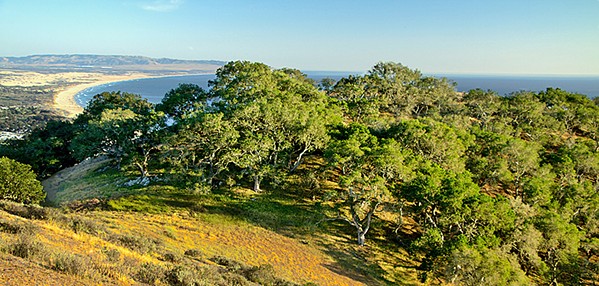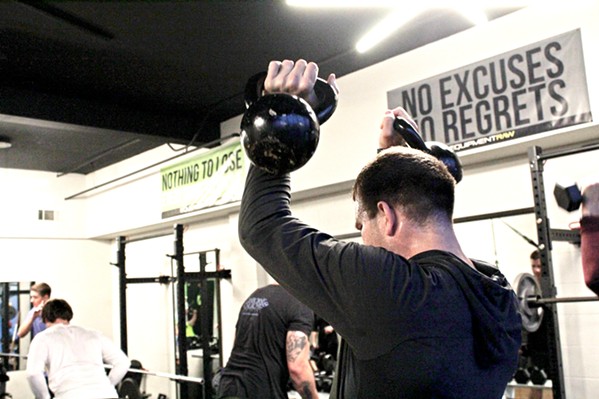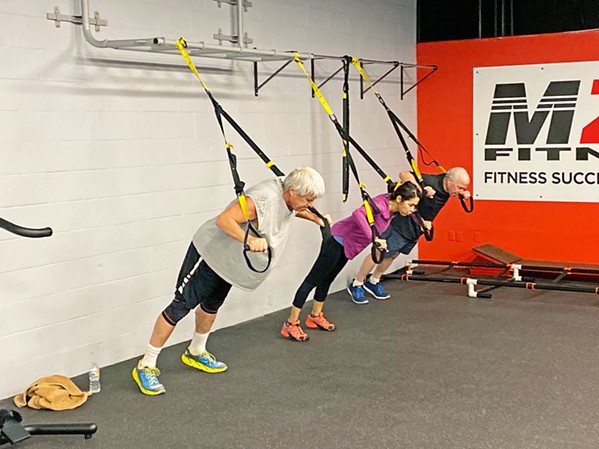[{
"name": "Newsletter Promo",
"id": "NewsletterPromo",
"class": "inlineCenter",
"insertPoint": "4",
"component": "15264767",
"requiredCountToDisplay": "0"
},{
"name": "Ad - Medium Rectangle CC01 - 300x250",
"id": "AdMediumRectangleCC01300x250",
"class": "inlineCenter",
"insertPoint": "8",
"component": "2963441",
"requiredCountToDisplay": "12"
},{
"name": "Ad - Medium Rectangle LC01 - 300x250",
"id": "AdMediumRectangleCC01300x250",
"class": "inlineCenter",
"insertPoint": "18",
"component": "2963441",
"requiredCountToDisplay": "22"
},{
"name": "Ad - Medium Rectangle LC09 - 300x250",
"id": "AdMediumRectangleLC09300x250",
"class": "inlineCenter",
"insertPoint": "28",
"component": "3252660",
"requiredCountToDisplay": "32"
}]
Do you have your New Year’s resolutions out and ready? Well, I’ve already forgotten mine, but if yours have anything to do with your health, this is the issue for you. In New Times’ annual Health and Wellness Issue, you can find out more about the direct primary care model of delivering health care and how it’s different than the current business model , new open space trails for hikers, bikers, and horseback riders coming to a hillside near you , and local gyms that personalize fitness programs for their clients.
—Camillia Lanham, editor
The direct primary care model revitalizes the doctor-patient relationship
By Karen Garcia
PJ Lloyd has a unique living situation due to her career in digital marketing, technology marketing, and web development. She spends half her time in Minneapolis and the remainder of it in California.
Her primary care doctor, who Lloyd has seen for several years, is in Minneapolis, but Lloyd said her overall experience hasn't been positive.
She's recently experienced a health issue that she's tried to communicate to her doctor but found it challenging.
"It was as though he wasn't listening to the symptoms and the issues I was having. It was more of a quick in-and-out," Lloyd said.
Lloyd explained her situation to a friend on the Central Coast who referred her to Dr. Lindsey Faucette, who handles her practice a little differently than the chain hospitals and concierge medical practices in the area.
Dr. Faucette follows the direct primary care model, which isn't new but is becoming more prevalent throughout the U.S.
As opposed to hospital chains—nonprofit and for-profit—that bill insurance companies for their patients, direct primary care cuts out the middleman by taking direct payment from the patient through a flat monthly rate. The model decreases the cost of seeing a doctor and increases the amount of time a doctor can spend with a patient.
Dr. Faucette opened her practice, the SLO Health Center, in San Luis Obispo in 2019.
Lloyd hasn't seen Dr. Faucette in person yet, but she's sent the doctor her medical records, and they've had several phone calls—the initial consultation and conversations about Lloyd's overall health as well as her recent concerns.
"[Dr. Faucette] made me feel like my situation, at that point she was on the phone with me, was the most important part of her day," Lloyd said.
• • •
Sitting in her practice room with plenty of natural lighting, Dr. Faucette told New Times she could remember the exact moment she realized she didn't want to be in a modern hospital setting.
During residency training in New York City, where she trained in a federally qualified health center on Union Square, she was dissatisfied with the structure of the clinic because she rarely saw patients she knew.
"It was more often whoever just wound up on my schedule, and that tends to happen when these [hospital] systems get too big," she said.
Dr. Faucette said she remembers being in her program director's office and asking for more continuity with patients.
"We have to be able to see our patients and see what happens to them over time," she remembered telling her program director.
Dr. Faucette moved on to being a practicing physician at a hospital in California with the same issues: No doctor and patient foundation, the call center for the hospital was outsourced, and there wasn't enough time to understand each patient's needs.
The modern hospital setting didn't make sense to Dr. Faucette, whose medical background is focused on osteopathic and family medicine. Osteopathic medicine has all the benefits of modern medicine but it emphasizes health promotion and disease prevention by taking an overall wellness approach. She believes that part of that approach is taking the time to get to know the patient and understand their medical history.
For seven years, she was a physician and educator at a family medicine residency. Dr. Faucette decided to leave after learning about the direct primary care model and the Direct Primary Care Alliance, a membership organization for direct primary care physicians who partner with their patients to provide primary care services under a flat periodic membership fee.
In 2019, Dr. Faucette left what she calls "corporate medicine," following her lifelong dream of forming relationships built on trust with her patients. The SLO Health Center is subscription-based—patients pay a flat monthly rate based on their age. Through her practice, Dr. Faucette offers no co-pays, an unlimited number of visits, accessibility to her through email, text, or phone, as well as home visits. She's also able to call or text doctors and laboratory offices on her own time, to talk about her patients or get laboratory results.
For a new patient, Dr. Faucette schedules a two-hour appointment to understand the patient's history, his or her concerns, and come up with a unique comprehensive plan. Follow-up appointments can range from 15 to 30 minutes, depending on the situation.
She said she's able to offer these benefits because she's keeping her patient list to 200 to 300 patients—as opposed to the typical 1,000 to 3,000 patients per doctor. The increased time for health care delivery comes from the doctor not having to bill insurance, write down the codes for every check and procedure done, or submit medical notes to an insurance agency.
• • •
Physician Dr. Julie Gunther from Boise, Idaho, was the first to open a direct care practice in Southwest Idaho in early 2014. She's also one of the founding members and current president of the Direct Primary Care Alliance—the physician run, founded, and direct primary care physician organization.
Dr. Gunther said the heart of the organization is to revitalize direct medical care to patients, but it came about because of physician suicide and burnout.
According to a review of 10 years of literature presented at the American Psychiatry Association in 2018, an estimated 300 to 400 doctors kill themselves each year.
A recent online survey of doctors completed by the American Medical Association found an overall physician burnout rate of 44 percent, with 15 percent saying they experienced colloquial or clinical forms of depression. Physician burnout, according to the Agency for Healthcare Research and Quality, is a long-term stress reaction marked by emotional exhaustion, depersonalization, and a lack of sense of personal accomplishment.
Dr. Gunther was one of many physicians who experienced burnout and said direct primary care saved her and gave her the ability to be the doctor she set out to be.
On top of this resurgence of direct medical care, Dr. Gunther said physicians are going back to being the "Swiss Army knives of medicine"—doctors who are trained and can treat the entire body (in most cases).
"Family physicians are sort of reclaiming their scope of practice and saying, 'You know I can take that off a patient's back and it costs me 10 bucks in supplies and a half hour's time,'" she said.
It significantly reduces the amount of money a patient spends, she said. An example would be trying to get a referral to a dermatologist, where patients pay for the initial consultation with the specialist plus the cost of the procedure.
However, Dr. Gunther said that direct care isn't the same as concierge medicine. Both are alternative ways to deliver health care that have shifted from the modern business model, but she said the end goal and spirit of each model is different. While concierge physicians can provide complete care for a reasonable fee, these practices typically take insurance and charge a fee on top of that.
In a typical direct primary care practice, it's just a flat rate, Dr. Gunther said, which is normally less than $100 per person per month. It doesn't matter whether the patient doesn't have an insurance card, a green card, or a Social Security card—that person will be provided medical care.
• • •
Appalenia Udell, a Colorado-based health lawyer for doctors, helped write the Colorado Direct Primary Care Act of 2017, which exempts practices following the model from state insurance regulations.
Udell is now working on making Medicare accessible for direct primary care physicians. She issued a letter of intent to the Centers for Medicaid and Medicare Services—a division of the U.S. Department of Health and Human Services that administers the Medicare program—in December 2019 saying that she wants Medicare to be a direct contracting entity.
"We just want to work with direct primary care practices and enable them to get their monthly fee through Medicare, rather than not seeing Medicare beneficiaries at all, or going through a traditional fee for service," she said.
She wants direct care practices to be able to partner with state-based Medicare programs, including Medi-Cal. Patients using Medicare tend to have complex or chronic health conditions, Udell said, that have been shown to benefit greatly from enhanced care offered by the direct primary care model, while simultaneously addressing the heightened cost of care for these patients.
The process to approve the initiative includes submitting a formal application (along with a list of physicians who are behind the initiative) by Feb. 25 and implementing the initiative by June 30. If successful, the initiative would be available Jan. 1, 2021.
Udell joined Dr. Faucette in bringing the idea to SLO Mayor Heidi Harmon. Harmon told New Times she thinks the model could provide a level of care that would really benefit all kinds of people in the community.
Aside from providing an alternative method of affordable health care delivery to city employees, the community at-large, and Cal Poly students, the direct care model could also benefit homeless individuals who are on Medi-Cal or Medicare. SLO County Jail inmates could receive this care while in custody, and transgender youth and young adults could receive direct gender affirmation care.
"Until we make something like single-payer health care a reality in our country, these other models are providing deeper understanding and approach to medical care," Harmon said. "I've tried to create a community of care here in SLO, and the type of medical care [Dr. Faucette and Udell] are talking about really adds to that." Δ
Staff Writer Karen Garcia can be reached at [email protected].
Pismo Preserve opens Jan. 25, while new SLO city trails are just a few months away
By Peter Johnson
This year promises to be an exciting time for local hikers, runners, mountain bikers, horseback riders, and open space enthusiasts.
After more than five years of work and millions of dollars of investment, the Pismo Preserve opens to the public on Jan. 25.
The 880-acre former ranch, located just east of the Five Cities area, offers 11 miles of multi-use trails, with sweeping views of the coastline and surrounding region.
Kaila Dettman, executive director for the Land Conservancy of San Luis Obispo County—which owns the property and has led the effort to transform it into a preserve—told New Times that she had "no adequate words to describe what it's like to explore that space."
"We want to share it with everybody," Dettman said. "I'd say we're all grinning ear to ear to be able to finally open this up to everyday use."
Open from 6 a.m. to 7 p.m. (and 9:30 p.m. during daylight saving time) every day, the preserve and its network of trails are accessible via Mattie Road in Pismo Beach. A parking lot at its dead end accommodates 54 vehicles, including three horse trailers (available by reservation only, except for Horse Trailer Tuesdays—on the first and third Tuesday of each month, the parking lot is available only to horse trailers).
The land brings much-needed open space recreation to South County, Dettman said, and it's expected to draw 100,000 visitors per year.
"When we set out to do this," she said, "we wanted to create something unique to the Five Cities area, something the residents don't already have."
The trails are organized into five segments. There are three "loops" that explore different parts of the preserve at different elevations: Discovery (5.2 miles), Spring to Spring (3.4 miles), and Lone Oak (2.2 miles). Then there's the mellower (and hiking-only) option: Vamonos Canyon (0.75 miles). And, finally, the Panhandle (1.1 miles) is an out-and-back trail that takes you to the highest point in the preserve at 916 feet: the Avila Overlook.
"You can choose your adventure," Dettman said. "The great thing is [the trails] are all on mild to moderate slope. You rise about 800 to 900 feet on one of the loops, but it doesn't really feel like you've climbed that much. They give incredible panoramic views of the Pacific Ocean [and also] meander through oak woodlands. You get a little bit of everything."
Most of the Pismo Preserve's trails are open to hikers, mountain bikers, and horseback riders. During their creation in 2016, the local biking and equestrian communities played important roles.
Scott Couture, a Land Conservancy staffer and board member for the Central Coast Concerned Mountain Bikers organization, told New Times that bike club members and design professionals worked together to "flag out sustainable routes throughout the property."
"That process was six months of work of laying flag lines down," Couture explained. "We built all our trails with sustainable grades in mind, of 5 to 7 percent grades. We built the Pismo Preserve always as a place for all users."
Building the trails required a machine operator out of Santa Cruz and more than 230 volunteers over a three-month period. Couture said he's thrilled with the results. He categorized the trails as "intermediate" for mountain bikers.
"They're not aggressive trails," he said. "We did that on purpose."
The biggest sell of the open space for users, he said, is the environment itself. Couture described the coastal views offered on its trails as "Big Sur-esque."
"It's just a really beautiful location," Couture said. "The Five Cities zone doesn't have that much open space and trails available to them, so it really gives that community, which is underserved, an open space they can use."
Miossi Open Space coming to SLO
In case the Pismo Preserve isn't enough to explore in 2020, the city of SLO is also getting ready to unveil its latest open space acquisition.
The Miossi Open Space, a 266-acre ranch wedged between Poly Canyon and Highway 101 at the bottom of the Cuesta Grade, is slated to open this spring or summer. On Jan. 14, the SLO City Council approved a conservation plan for the land, which the city purchased in 2018 for $1.3 million.
Bob Hill, SLO's sustainability and natural resources official, said the new open space "provides a really nice opportunity for trail connections between Poly Canyon, over to [Old] Stagecoach [Road], and up toward Los Padres National Forest." The Miossi Open Space adds to the more than 7,500 acres of greenbelt already preserved by the city.
"Miossi Open Space fills a gap," Hill said, speaking to the space between Cal Poly lands, Stenner Creek Open Space, and the Reservoir Canyon Open Space across Highway 101.
The property will likely offer three new trail segments that, for the most part, will be open to both hikers and bikers. There's a loop along the top, a trail along the bottom, and a short trail to reach the summit at nearly 1,500 feet.
Before its grand opening, the city has to finish the trails, install fencing, signage, kiosks, and amenities like trash cans and mutt mitts, and arrange native tribal site visits. Δ
Assistant Editor Peter Johnson can be reached at [email protected].
Orangetheory is coming to town, but here are two local gyms you could support instead
By Kasey Bubnash
It was October 2018 when national fitness chain Orangetheory announced it'd be coming to San Luis Obispo to offer its renowned "science-backed, technology-tracked" group workouts to residents of the Central Coast. The news was met with enthusiasm from many of SLO's gym rats, and although Orangetheory's new location at 3865 S. Higuera St. hasn't even opened to the general public, its Facebook page already has 431 followers. A grand opening date still hasn't been set.
So whether you're sick of waiting for Orangetheory to open its doors or your checkbook simply can't handle its prices, here are two local gyms offering awesome group fitness services at reasonable (and free) prices.
Rev SLO Fitness
Chatter quiets and gymgoers gather around as fitness trainer Corey Stollmeyer welcomes the class and strolls over to a whiteboard containing a list of the day's exercises. Some attendees mindlessly stretch as Stollmeyer describes what each workout will entail, some nervously chew at their nails, and others plant their hands firmly on their hips and squint to better see the board.
Everyone groans when Stollmeyer mentions 3-minute planks.
The intro doesn't take long—everyone in this class has been here before—and when Stollmeyer claps his hands, attendees hustle to their stations and get in position. He pumps up the music, turns on his stopwatch, and everyone starts.
"Happy Thursday, baby!" he shouts, while each of his red-faced pupils—all focused on a different exercise in the circuit—squat, jump, and plank, all at their own pace.
"Keep it going," Stollmeyer yells while clapping. "Just 15 more seconds!"
This is the kind of personalized, coach-athlete model that clients at Rev SLO Fitness pay for. Whether it's one of Rev's many circuit, spin, and bootcamp classes, or its personal training services, Stollmeyer says customers are able to customize their workouts to match whatever level of difficulty they're comfortable with.
Trainers at Rev like to keep their classes small so that each client has as intimate a workout as possible. Even the spin room—which, aside from a few black lights, is kept in total darkness during sessions—allows for more privacy during a workout.
That's what Rev is all about.
"Fitness designed for you," Stollmeyer plugs with a proud smile.
Rev, run by Stollmeyer and his brother Darik, is celebrating its 10th year in business, and as part of the festivities, Stollmeyer says the gym is offering a number of new services. A recently completed remodel and expansion—which essentially doubled the spin and training rooms and the outdoor exercise space—allowed for additional equipment.
They've added classes and open gym hours on Saturdays and Sundays, they're hosting 11 classes every weekday, and they're offering discounted prices for the new year.
While Stollmeyer says Rev's updates aren't a response to the news that Orangetheory is coming to town, he admits that a lot of local gyms are upping the ante in preparation for the fitness giant's arrival.
But he's not worried about losing business. Rev has more than 100 clients, lower prices, and close ties to the SLO fitness community.
"I think people will see local is better than a corporate model," he says.
MZR Fitness
When Mike Robinson was 15 years old, he and a friend joined a gym and started working out for about four to five hours every day. They weren't sure what to do or how to do it, so they just copied whatever they saw the "buff guys" doing. Robinson was ripped.
But one day, Robinson's right arm gave out while he was bench-pressing. The weights came crashing down on him, and he could tell something was wrong with his shoulder. He found out that his injury was caused by overuse. He had to completely stop exercising his upper body and go through physical therapy.
His parents loved that he was so motivated and interested in health, but they were afraid he'd hurt himself again. They hired a personal trainer who could teach him how to stay fit without overdoing it.
"I was able to learn to lift smarter rather than harder," Robinson told New Times.
That was about 20 years ago, and Robinson said his trainer inspired him to pursue fitness as a career and to open the gym he owns now, MZR Fitness.
Robinson's gym operates on a specialized training model, meaning clients each get a training and nutrition plan customized to meet their specific needs. MZR offers personal and group training services, fitness classes, nutrition programs, youth athletics, and community classes.
To help celebrate MZR's 10th anniversary, the gym moved to a facility at 3536 S. Higuera St. that's nearly triple the size of its previous location. That, Robinson said, allowed him to install a plethora of new exercise machines. It also gives him more room to host his youth and family programs, which he hopes to give more attention in coming years.
Robinson recently launched MZR's Fitness Healthy Families Program, and he will be offering a free 12-week fitness program to families struggling financially. Families who join will each get a customized workout and nutrition plan and will have unlimited access to all MZR classes, which operate five days a week in the morning, at lunch, and in the evening.
The gym is also hosting free, community workouts the first Saturday of every month.
To Robinson, both programs are a way to give back to the community that's given him such a strong and devoted customer base for years.
"We don't want finances to come between someone being healthy and not being healthy," he said.
Despite Orangetheory's nationwide customer base, Robinson moved into a location just down the street from Orangetheory's soon-to-come facility. Still an athlete at heart, Robinson said he's actually looking forward to having another gym in town.
"It's always good to have more competition," Robinson said.
For more information on Rev SLO Fitness (755 Alphonso St.) visit revslo.com. To find out more about MZR (3536 S. Higuera St.) fitness, head to mzrfitness.com. Δ
Staff Writer Kasey Bubnash can be reached at [email protected].
Latest in News
Readers also liked…
-

Coast Unified teachers upset over new position's salary and qualifications
Oct 20, 2022 -

SLO police identify alleged driver who hit and killed couple
Dec 22, 2022 -

When the levee breaks: Oceano residents, county officials walk a tightrope of regulations to manage Arroyo Grande Creek, which some say led to the levee's failure in January
May 18, 2023

